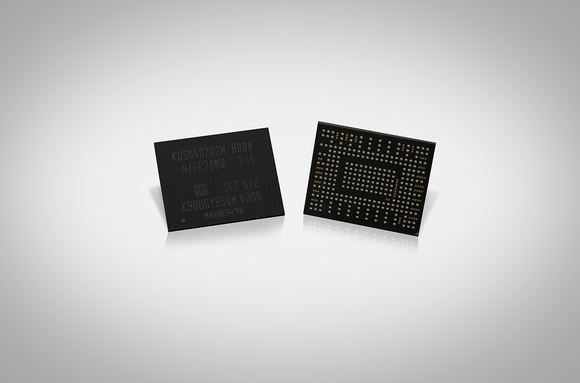A First Look At Samsung's PM971 Entry-Level NVMe SSD
Last week we broke the Samsung PM981 / 980 NVMe SSD story with a first look at the drive in 512GB and 1TB capacity sizes. Today we tracked down the PM971 NVMe SSD that may come to market with Samsung SSD 970 branding.
The PM971 was first introduced to us as a 22mm x 16mm x 1.5mm multichip package that crams the Samsung Proton controller, LPDDR4 DRAM, and V-NAND flash into a single chip. The drive is said to deliver up to 1,500 MBps sequential read and up to 900 MBps sequential write speeds. Samsung claims random performance up to 190,000 IOPS read and 170,000 IOPS write.
These are the first images of the PM971 in an M.2 form factor.
When announced, Samsung stated the PM971-NVMe BGA drive would ship in 128GB, 256GB, and 512GB capacity sizes. With new 64-layer V-NAND in both TLC and QLC on the horizon, Samsung could quickly ramp up capacity sizes. This product could be used to aggressively enter the consumer entry-level NVMe segment where the Intel 600p currently owns the majority of the marketshare.
BGA SSDs are not sold to consumers as standalone components because they are embedded parts that must be installed by expensive machines. Samsung will not be the only company to release a BGA SSD soldered to an M.2 card, but the PM971 may be the most exciting. The other products in this configuration are DRAMless models with Host Memory Buffer (HMB) technology. The PM971 still has an actual DRAM chip, even if we can't see it. We've proven that DRAM is required to deliver a pleasant user experience with our extensive product testing.
MORE: Best SSDs
MORE: How We Test HDDs And SSDs
Get Tom's Hardware's best news and in-depth reviews, straight to your inbox.
MORE: All SSD Content

Chris Ramseyer was a senior contributing editor for Tom's Hardware. He tested and reviewed consumer storage.
-
Giroro Hold on, why are we talking about the soldering technology? Aren't the vast majority of flash chips already using Ball Gate Array (BGA)?Reply
I assume the real news is that this drive uses fewer chips than normal. So shouldn't we be calling this a System On a Chip (SOC) Instead? -
Tanyac Regardless of how it mounts, the specs for this drive are quite unimpressive.Reply
Given how long the 950 pro and 960 pro have been out, the specs of those drives should be the baseline of any new model. The PM971 is reminiscent of the AHCI PM951 drive.
Disappointing -
Valantar Reply20304846 said:Hold on, why are we talking about the soldering technology? Aren't the vast majority of flash chips already using Ball Gate Array (BGA)?
I assume the real news is that this drive uses fewer chips than normal. So shouldn't we be calling this a System On a Chip (SOC) Instead?
The difference is that the m.2 card here is nothing more than a riser card - the entire SSD is one BGA package, as opposed to a controller, RAM, flash chips, and all the capacitors and resistors and stuff required to keep it working right. This has absolutely everything integrated. I love that they're making an m.2 version, though - BGA SSDs soldered to the motherboard is kind of a nightmare scenario. This, on the other hand, should be compact enough for all but the most tiny devices, while still being replaceable. Love it. -
Rodney Wilder Reply20306011 said:20304846 said:Hold on, why are we talking about the soldering technology? Aren't the vast majority of flash chips already using Ball Gate Array (BGA)?
I assume the real news is that this drive uses fewer chips than normal. So shouldn't we be calling this a System On a Chip (SOC) Instead?
The difference is that the m.2 card here is nothing more than a riser card - the entire SSD is one BGA package, as opposed to a controller, RAM, flash chips, and all the capacitors and resistors and stuff required to keep it working right. This has absolutely everything integrated. I love that they're making an m.2 version, though - BGA SSDs soldered to the motherboard is kind of a nightmare scenario. This, on the other hand, should be compact enough for all but the most tiny devices, while still being replaceable. Love it.
This also allows for larger capacity and newer/cheaper or more reliable M.2 drives in the shorter 2242 (42mm long) and 2230 lengths. Of note, most m.2 devices currently on the market are 2280 (80mm long), there are very few 2242 models currently available, especially in sizes over 250gb. I have multiple 2U rack servers which cannot accept m.2 drive longer than a 2242 which greatly limits options. Fairly certain also have a few all-in-1 pcs which accept only 2242 length m.2 ssds

